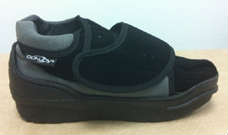What will the surgery involve?
i. Anaesthetic – Usually a light general anaesthetic together with a local anaesthetic around the ankle
ii. Scars – This will be over the top or on the inside of the big toe joint, alternatively it may be possible to perform the surgery through a couple of tiny incisions (minimally invasive or key hole surgery).
iii. The surgery – As a result of the arthritis developing in the joint at the base of the big toe extra bone is formed on the top of one of the bones (the metatarsal), this causes pain when the toe is bent upwards. This is removed and if necessary any areas of cartilage damage are looked for and dealt with.
iv. Stitches – Removable sutures are usually required (possibly not if the operation is performed using the keyhole technique) these will be removed at your appointment about two weeks after surgery.
 v. Dressings – A special dressing will be placed on the foot that should be left in place until you are reviewed in clinic. Bandages will be placed on top of the dressing, you will be instructed as to when you can remove the bandages.
v. Dressings – A special dressing will be placed on the foot that should be left in place until you are reviewed in clinic. Bandages will be placed on top of the dressing, you will be instructed as to when you can remove the bandages.
You will have a “post operative shoe” rather than a plaster.
What happens after the surgery?
i. Going home – Either the same day or the following morning.
ii. Pain relief – The local anaesthetic ankle should provide some pain relief, but you will be supplied with pain relieving tablets by the hospital (usually co-codamol and tramadol) these should be taken regularly initially. You can gradually reduce these as your pain allows (tramadol is the stronger pain killer).
The local anaesthetic placed around the ankle at the time of surgery will wear off several hours after surgery. It is important to take the pain relieving tablets regularly before the local anaesthetic wears off. You can gradually reduce the frequency with which you take these after twenty four hours.
iii. Walking – You will be able to walk when you have recovered sufficiently following the general anaesthetic.
It is important to keep your foot elevated when you are resting, as much as you can for the first two weeks after surgery (if possible above the level of your heart). If you do not keep it elevated then the foot will swell, throb and be uncomfortable.
iv. Shoes – You will be able to wear “more normal” shoes when the post operative shoe is removed, usually at 2-4 weeks following surgery. You may have some difficulty fitting into your normal shoes at this stage as the foot may be swollen, this can last up to 3 months.
v. Driving – This is not permitted until you can walk confidently in normal shoes, however if the surgery is on your left foot and you have an automatic car you may be able to drive after you are seen in the clinic two weeks after surgery.
In all cases you should check with your insurance company first.
vi. Follow up – You will be reviewed in the outpatient clinic at:
2 weeks after surgery for removal of sutures
8 weeks after surgery and further follow up will depend on your progress.
vii. Return to work
Office job – 2 weeks
Mobile job requiring driving – 2-3 weeks
Manual labour – 3-4 weeks
What are the risks of the operation?
There are a small number of risks of surgery including infection, nerve damage, blood clots, ongoing pain and the need for further surgery (please see General Risks of Foot and Ankle Surgery for further information)
